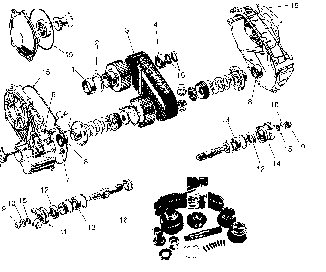
by Peter Matusov

 |
by Peter Matusov |
 |
| This page shows a few pictures of a famous part of Jeep's Quadratrac
full-time four-wheel drive system - the transfer case. The case is aluminum,
chain-driven, in stock version - with limited-slip central differential
(fully lockable from the cab, via vacuum motor). Optional with Quadratrac
was low-range unit - bolt-on to the rear of the case. Its planetary gearset
offered 2.57 low-range ratio - pitch in 360 or 401 c.i.d. V8, and TH-400
auto transmission (6.7 effective low-rpm ratio), and you get serious stump-pulling
power!
Milemarker makes a part-time conversion kit for this transfer case, which replaces the differential carrier with a spool. There are two versions of this conversion - normal and 16% overdrive, aimed at some fuel savings. My jeep's case had this OD conversion - and am I a happy camper of not having it anymore. It is too early to report any gas mileage changes from going back from part-time overdrive to stock full-time case, but street and highway performance are incredibly better without overdrive. Guess having 16% lower (numerically higher) gearing never hurts off-road. I was considering shelling out big bucks to re-gear my axles - and went up (in comparable R&P numbers) from 3.54 to 4.11 for $150 I paid for the old case from a parts jeep! At the right there is a blow-up picture of Borg-Warner 1339 transfer case, scanned from 4 Wheel Parts Wholesalers Jeep catalog. Below are some photographs of the real Quadratrac case that I took in my garage, with part numbers roughly corresponding to these on the drawing at right. |

The group of parts near the bottom of the picture is what comes in Milemarker conversion kit (may or may not include chain, lockout hubs, etc.). The drawing is scanned from MM catalog. |
|
|
|
|
| 1. Highway drivability - improved somewhat. Gained some acceleration at 65-70+ mph range. | Lost some acceleration at 75-80+ mph range | |
| 2. Highway grades - incredible gain: before the swap, the detonation was killing my engine, causing be to back off the throttle, and limping up the hill at 45-50 mph, watching them Chevy trucks blasting by. Now, 75 mph correspond to 3,000 rpm of the engine, above (not below) the book-listed torque peak. I was able to drive up several miles-long grades on Interstate 8 in the left lane, beating all the traffic (except one Saleen Mustang :-), and my temperature gauge needle never even hit the middle of the scale! | Lost 1-1.5 mpg in gas mileage (highway). Should be less than that in the city.. | |
| 3. Mountain two-lane twisty highways - as there always is somebody in a rental Ford Taurus or Toyota Corolla, gripping the steer with white knuckles and doing whatever is possible not to hit the 50% of the legal speed limit, I noticed only slight improvement. One big gain - engine runs cooler, otherwise I would have been unable to climb the hwy30/330/18 from San Bernardino to Big Bear Lake in 90F+ weather. | I suspect increased wear on front tires, and all front drivetrain. No figures will come out, since all that was already worn out, but I may hit the garage floor sooner than I would expect otherwise. | |
| 4. City driving - noticeable and pleasant improvement. Come to think of it, not only I have 16% less overall drive ratio, the same speed comes at 16% higher rpm. As light take-offs occur within 1,500 rpm range, I would assume the torque rising almost linearly with rpm, so I gained somewhat near 30% of acceleration power! Not a bimmer, of course, but not that dog, either. | ||
|
|
||
| 6. 4-LO trails - major improvement is in having differentiated four-wheel drive. I've been in a few situations where very tight U- and S-turns came on a rocky surface with good traction. Here 4WD doesn't interfere with turning, making things look nicer. In one or two turns on the trail I've done before my T-case swap, my jeep went through as in 2WD, while before it skid somewhat. Too bad we're getting about 10" of annual precipitation, so I can't enjoy full-time 4WD as much as I did in Motor City. | ||
Guess that's about it. Keep in mind that since I still have lockout
hubs up front, I still have an option of 2-HI and 2-LO - all I need is
to unlock the hubs and flip in this "Emergency Drive" switch, so now I
have the best of all worlds possible!